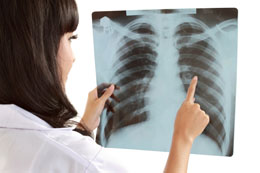Blunt trauma to the chest, violent coughing, or a motor vehicle accident can cause the ribs to fracture or develop cracks. This write-up provides information on the healing time and treatment options for such a rib injury.

The human rib cage consists of 12 pairs of ribs. These are grouped into true ribs, false ribs, and floating ribs. The true ribs are the first seven pairs that are directly connected to sternum through the costal cartilage. The next three pairs, which are also known as false ribs, are connected to the spine at the back, but are not directly attached to the sternum at the front. These are attached to the lowest true rib. Floating ribs are the last two sets of ribs that are not connected to the sternum at the front, but are connected to the spine at the back. Out of these, the middle ribs are the most susceptible to fractures. The upper ones are supported by the collarbone as well as the shoulder blades and the lower set of ribs are flexible as they are not attached to the sternum.
The ribs can get bruised or even develop cracks due to chest trauma. More often than not, this occurs due to a blow to the chest or in the event of a heavy object falling on the chest. Though the distressing symptoms can be managed to some extent with the help of drugs, following certain self-care measures will surely prove beneficial in speeding up the healing process. It is the extent of damage that will determine the time one may take to recover from a rib injury. The risk of complications is high, if the rib breaks and gets displaced.
Causes of Rib Injuries
Cracked ribs or development of tears in the cartilage is most likely to be caused due to vehicle accidents, falls, or injuries. A motor vehicle accident wherein the chest slams against the steering wheel is one of the common causes of cracked or bruised ribs. Changes in bone density could also increase the risk of rib fractures. An individual who is affected by osteoporosis is most likely to end up with broken or bruised ribs in the event of such accidents or falls. Intercostal strains and severe coughing spells over a prolonged period of time can also cause the ribs to fracture.
The symptoms that the affected individual is likely to experience include:
- Rib cage pain
- Swelling
- Painful breathing
- Pain that is felt on touching the affected area
- Pain that worsens on twisting or bending
- Risk of internal bleeding or organ damage in the event of displaced fracture
The extent of damage can be ascertained with the help of an X-ray examination, or imaging procedures such as a CT scan and bone scan.
Treatment Options
While healing time for bruised ribs typically ranges anywhere between 5 to 6 weeks, rib fractures might take longer to heal. The time one would take to recover would also vary, depending on the overall health of the patient. It might range from 6 weeks to 6 months. However, following certain self-care measures will surely help in speeding up the recovery process. Taking adequate rest is extremely important. The affected individual must refrain from performing any strenuous physical activity that might worsen his/her condition. The treatment options usually include:
- Drug therapy involving the use of analgesics, anti-inflammatory drugs, nerve block injections, steroids, etc.
- Application of ice to reduce the swelling
- The use of spirometer to help the patient breathe easily
- Breathing exercises
While stress fracture and simple, non-displaced rib fracture have a good prognosis, displaced multiple fractures can be life-threatening and the patient might need to be immediately operated upon.
In case of a rib fracture, the affected individual is likely to experience rib cage pain and discomfort till the ribs heal completely. Seek medical help immediately for prompt treatment and follow self-care measures to speed up the recovery process.
Disclaimer:
The information provided in this article is solely for educating the reader. It is not intended to be a substitute for the advice of a medical expert.


 The human rib cage consists of 12 pairs of ribs. These are grouped into true ribs, false ribs, and floating ribs. The true ribs are the first seven pairs that are directly connected to sternum through the costal cartilage. The next three pairs, which are also known as false ribs, are connected to the spine at the back, but are not directly attached to the sternum at the front. These are attached to the lowest true rib. Floating ribs are the last two sets of ribs that are not connected to the sternum at the front, but are connected to the spine at the back. Out of these, the middle ribs are the most susceptible to fractures. The upper ones are supported by the collarbone as well as the shoulder blades and the lower set of ribs are flexible as they are not attached to the sternum.
The human rib cage consists of 12 pairs of ribs. These are grouped into true ribs, false ribs, and floating ribs. The true ribs are the first seven pairs that are directly connected to sternum through the costal cartilage. The next three pairs, which are also known as false ribs, are connected to the spine at the back, but are not directly attached to the sternum at the front. These are attached to the lowest true rib. Floating ribs are the last two sets of ribs that are not connected to the sternum at the front, but are connected to the spine at the back. Out of these, the middle ribs are the most susceptible to fractures. The upper ones are supported by the collarbone as well as the shoulder blades and the lower set of ribs are flexible as they are not attached to the sternum.